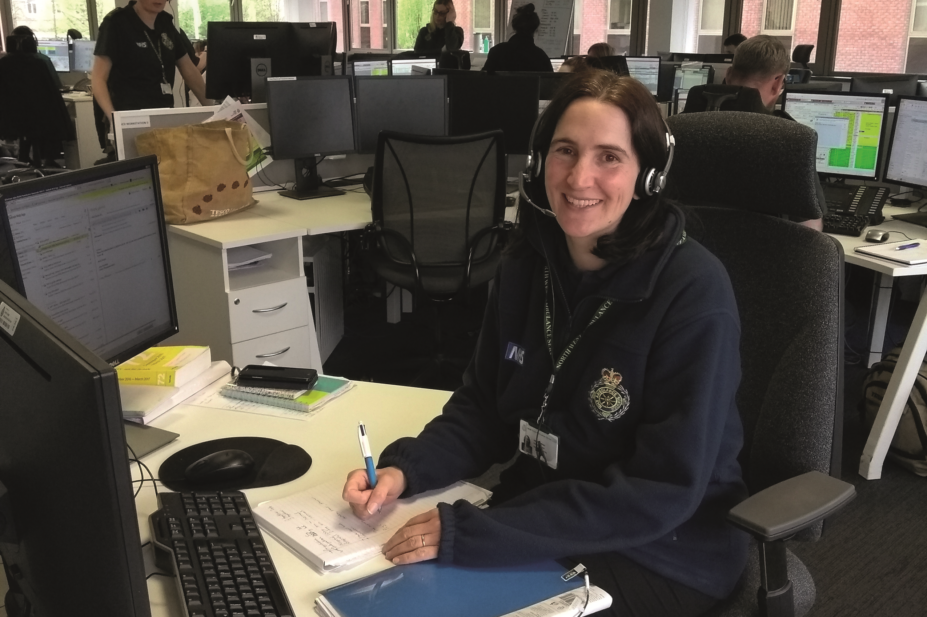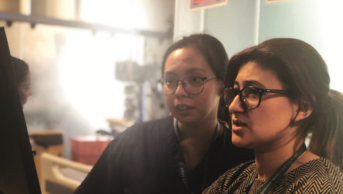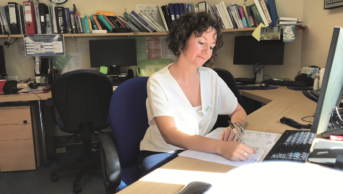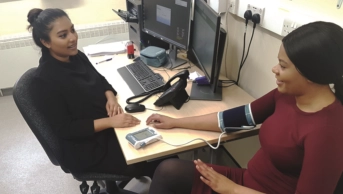
Courtesy of Julia Whettam
Two years ago I began working at the North West Ambulance Service (NWAS) in a pilot project led by the Manchester University NHS Foundation Trust Community Medicines Optimisation Service. The project aimed to explore the role of pharmacists in the urgent care setting. Our role has evolved since then, and pharmacists are now an integral part of the team at NWAS.
10:00 start
Today I am working a 12-hour shift (10:00 until 22:00) and it is nearly the end of the month, so I need to catch up on auditing calls. As an audit team we review around 40 pharmacist calls per month.
While working on the audits, one of the paramedics asks me for some advice. An older patient has mistakenly been given her evening medication this morning. My colleague wants to know which tablets the patient can take this evening, and which should be omitted.
After completing the audits, I work on training materials for the University of Derby — which is developing an integrated urgent care (IUC) pharmacist course. This course is funded by the NHS England Pharmacy Integration Fund, with the aim of supporting the clinical and professional development of pharmacists working in the IUC setting. I am working on the paracetamol overdose chapter today. I enjoy writing scenarios and producing material that will challenge the students and get them to think in detail around the subject. I am excited about this course — it will be an excellent tool for anyone wanting to work in urgent care.
13:00
After lunch, I spend five hours on the call desk. I review the 999 and 111 calls that are waiting and choose appropriate cases to call back. We focus on intentional and accidental overdoses, but I am also trained across other areas, including: allergy, diabetes, nausea and vomiting, and ear problems. It’s busy today, with several of the usual 111 calls, such as double doses of Calpol® (Johnson & Johnson); a carer working in a care home who gave someone else’s medicines to a resident; earache; and even a toddler who has eaten cat poo! Then comes one of the difficult calls — a 25-year-old who has taken a huge quantity of tablets to end her life. Dealing with suicidal callers is one of the biggest challenges here. It can be disturbing listening to people who are so desperate that they want to take their own life.
Sometimes these calls really affect me and I can’t help thinking about the patient I spoke to. I know that I can talk to one of my colleagues if I need to, as a kind of debrief. All calls are recorded so it is possible to ask someone to listen to the call, or for me to listen to it with a senior colleague. There are specially trained people at NWAS who can help me to process a call if I have been badly affected by it. I’ve found that the more intentional overdose calls I do, the easier it is to cope with them. You learn not to dwell on them and to move on to the next call. You have to develop coping mechanisms otherwise it would become too much.
The mental health calls are the ones that my team find the hardest and, as such, we have additional training around triaging suicidal patients. We have a great resource in the form of the mental health nurses who are always happy to give advice and support to our team.
15:30
I am asked to contact some paramedics on scene asking for advice regarding a patient who has taken an overdose. They want to know if their patient has taken a toxic dose of paracetamol. I consult Toxbase
®, the clinical toxicology database of the National Poisons Information Service, and carry out the appropriate calculations. The dose is not toxic; however, as it was an intentional overdose the patient needs to be taken to the accident and emergency department.
17:00
I receive another request for advice from an ambulance crew. They are on the way to a child who has taken two of her brother’s methylphenidate tablets and want to know what symptoms they should be looking out for and how serious the overdose is. I consult Toxbase and establish that the child has taken a toxic amount; I describe the symptoms the ambulance crew may encounter. One of the frustrations of my job is that you never get to know the end of the story.
The clinical hub is a great place to work. There is a real sense of camaraderie, with paramedics, nurses, pharmacists and mental health nurses working side by side and giving support and advice to each other when needed.
18:00
The evening pharmacists arrive and I leave the call desk. I have a meeting planned with one of them. We spend an hour reviewing their previous two months’ performance, looking at audit results and call data, and discussing any issues that may have arisen. This month, I am highlighting the importance of undertaking peer reviews with colleagues in order to learn from each other. Pharmacists all have different approaches to triage and it is beneficial to listen to different members of staff in order to develop and improve our own approach.
As we near the end of this pilot project we are starting to discuss the future of the service. This evening, I need to prepare for an important meeting with the medical directors, clinical hub managers and 111 service managers. My colleague at Manchester University NHS Foundation Trust’s Community Medicines Optimisation Service provides medicines management and governance support to NWAS. Together, in preparation for this meeting, we have been discussing the potential areas of development for the NWAS pharmacy service.
21:00
For the last hour of my shift I check that I have all the paperwork ready for the next pharmacist meetings I have. I am up to date with things this month, so I spend time looking through my emails and deleting any irrelevant messages. I’ve had several messages from my team requesting rota changes: I work through these and update the rota where possible. I send a reminder email out about timesheets which are due in tomorrow.
22:00 finish
It’s been a busy shift and I feel ready to go home!
There is so much potential for pharmacists in the urgent care setting. It’s an exciting and dynamic environment to work in, and as pharmacists we have unique skills which contribute to the effectiveness of multidisciplinary teams already working in urgent care.
Box: How to get a job as an integrated urgent care pharmacist
If you are interested in working in an urgent care setting, you will need to have some post-qualification experience, demonstrate good clinical knowledge and the ability to work in a high pressure environment.
Some 111 providers have pharmacist independent prescribers, some are connected to clinical assessment services (CAS) with face-to-face assessment by pharmacists, and some hospital pharmacists rotate through integrated urgent care and CAS.
There are several things you can do to prepare for a role in this area:
- Watch webinars and read information about the role on the NHS England website;
- Be proactive in developing your urgent care skills by accessing training resources on urgent care, consultation skills, and mental health (e.g. at the Centre for Pharmacy Postgraduate Education);
- Find out if your local 111 service provider has a pharmacy team and ask to shadow a pharmacist for the day;
- Watch out for jobs advertised on NHS jobs, or approach your local 111 service provider directly.
If you decide to apply for a job, ensure that you call or visit the setting before your interview. Find out all you can about the service they provide in preparation for the interview.


